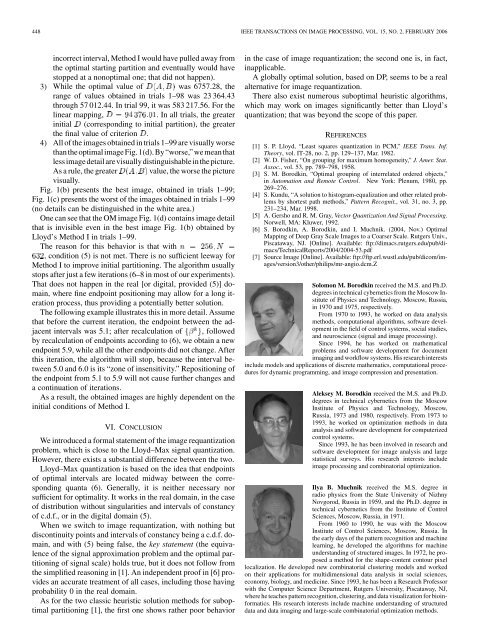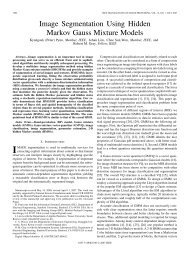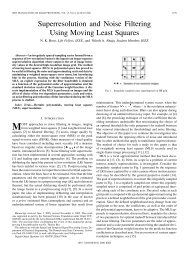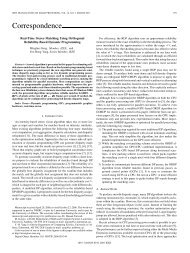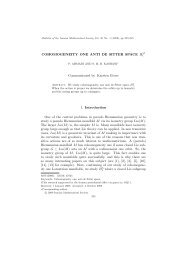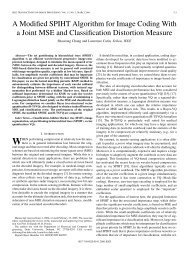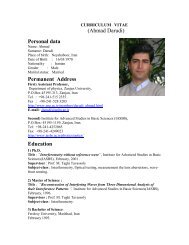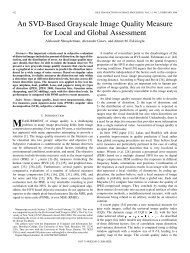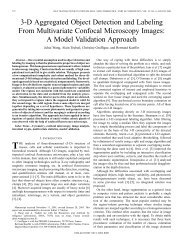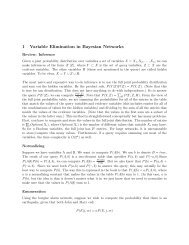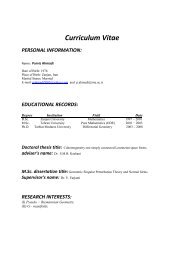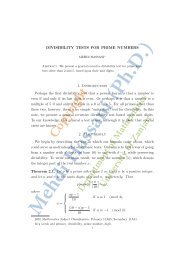Optimal requantization of deep grayscale images and Lloyd-Max ...
Optimal requantization of deep grayscale images and Lloyd-Max ...
Optimal requantization of deep grayscale images and Lloyd-Max ...
You also want an ePaper? Increase the reach of your titles
YUMPU automatically turns print PDFs into web optimized ePapers that Google loves.
448 IEEE TRANSACTIONS ON IMAGE PROCESSING, VOL. 15, NO. 2, FEBRUARY 2006<br />
incorrect interval, Method I would have pulled away from<br />
the optimal starting partition <strong>and</strong> eventually would have<br />
stopped at a nonoptimal one; that did not happen).<br />
3) While the optimal value <strong>of</strong> was 6757.28, the<br />
range <strong>of</strong> values obtained in trials 1–98 was 23 364.43<br />
through 57 012.44. In trial 99, it was 583 217.56. For the<br />
linear mapping,<br />
. In all trials, the greater<br />
initial (corresponding to initial partition), the greater<br />
the final value <strong>of</strong> criterion .<br />
4) All <strong>of</strong> the <strong>images</strong> obtained in trials 1–99 are visually worse<br />
thantheoptimalimageFig.1(d).By“worse,”wemeanthat<br />
lessimagedetailarevisuallydistinguishableinthepicture.<br />
As a rule, the greater value, the worse the picture<br />
visually.<br />
Fig. 1(b) presents the best image, obtained in trials 1–99;<br />
Fig. 1(c) presents the worst <strong>of</strong> the <strong>images</strong> obtained in trials 1–99<br />
(no details can be distinguished in the white area.)<br />
One can see that the OM image Fig. 1(d) contains image detail<br />
that is invisible even in the best image Fig. 1(b) obtained by<br />
<strong>Lloyd</strong>’s Method I in trials 1–99.<br />
The reason for this behavior is that with<br />
, condition (5) is not met. There is no sufficient leeway for<br />
Method I to improve initial partitioning. The algorithm usually<br />
stops after just a few iterations (6–8 in most <strong>of</strong> our experiments).<br />
That does not happen in the real [or digital, provided (5)] domain,<br />
where fine endpoint positioning may allow for a long iteration<br />
process, thus providing a potentially better solution.<br />
The following example illustrates this in more detail. Assume<br />
that before the current iteration, the endpoint between the adjacent<br />
intervals was 5.1; after recalculation <strong>of</strong> , followed<br />
by recalculation <strong>of</strong> endpoints according to (6), we obtain a new<br />
endpoint 5.9, while all the other endpoints did not change. After<br />
this iteration, the algorithm will stop, because the interval between<br />
5.0 <strong>and</strong> 6.0 is its “zone <strong>of</strong> insensitivity.” Repositioning <strong>of</strong><br />
the endpoint from 5.1 to 5.9 will not cause further changes <strong>and</strong><br />
a continuation <strong>of</strong> iterations.<br />
As a result, the obtained <strong>images</strong> are highly dependent on the<br />
initial conditions <strong>of</strong> Method I.<br />
VI. CONCLUSION<br />
We introduced a formal statement <strong>of</strong> the image <strong>requantization</strong><br />
problem, which is close to the <strong>Lloyd</strong>–<strong>Max</strong> signal quantization.<br />
However, there exists a substantial difference between the two.<br />
<strong>Lloyd</strong>–<strong>Max</strong> quantization is based on the idea that endpoints<br />
<strong>of</strong> optimal intervals are located midway between the corresponding<br />
quanta (6). Generally, it is neither necessary nor<br />
sufficient for optimality. It works in the real domain, in the case<br />
<strong>of</strong> distribution without singularities <strong>and</strong> intervals <strong>of</strong> constancy<br />
<strong>of</strong> c.d.f., or in the digital domain (5).<br />
When we switch to image <strong>requantization</strong>, with nothing but<br />
discontinuity points <strong>and</strong> intervals <strong>of</strong> constancy being a c.d.f. domain,<br />
<strong>and</strong> with (5) being false, the key statement (the equivalence<br />
<strong>of</strong> the signal approximation problem <strong>and</strong> the optimal partitioning<br />
<strong>of</strong> signal scale) holds true, but it does not follow from<br />
the simplified reasoning in [1]. An independent pro<strong>of</strong> in [6] provides<br />
an accurate treatment <strong>of</strong> all cases, including those having<br />
probability 0 in the real domain.<br />
As for the two classic heuristic solution methods for suboptimal<br />
partitioning [1], the first one shows rather poor behavior<br />
in the case <strong>of</strong> image <strong>requantization</strong>; the second one is, in fact,<br />
inapplicable.<br />
A globally optimal solution, based on DP, seems to be a real<br />
alternative for image <strong>requantization</strong>.<br />
There also exist numerous suboptimal heuristic algorithms,<br />
which may work on <strong>images</strong> significantly better than <strong>Lloyd</strong>’s<br />
quantization; that was beyond the scope <strong>of</strong> this paper.<br />
REFERENCES<br />
[1] S. P. <strong>Lloyd</strong>, “Least squares quantization in PCM,” IEEE Trans. Inf.<br />
Theory, vol. IT-28, no. 2, pp. 129–137, Mar. 1982.<br />
[2] W. D. Fisher, “On grouping for maximum homogeneity,” J. Amer. Stat.<br />
Assoc., vol. 53, pp. 789–798, 1958.<br />
[3] S. M. Borodkin, “<strong>Optimal</strong> grouping <strong>of</strong> interrelated ordered objects,”<br />
in Automation <strong>and</strong> Remote Control. New York: Plenum, 1980, pp.<br />
269–276.<br />
[4] S. Kundu, “A solution to histogram-equalization <strong>and</strong> other related problems<br />
by shortest path methods,” Pattern Recognit., vol. 31, no. 3, pp.<br />
231–234, Mar. 1998.<br />
[5] A. Gersho <strong>and</strong> R. M. Gray, Vector Quantization And Signal Processing.<br />
Norwell, MA: Kluwer, 1992.<br />
[6] S. Borodkin, A. Borodkin, <strong>and</strong> I. Muchnik. (2004, Nov.) <strong>Optimal</strong><br />
Mapping <strong>of</strong> Deep Gray Scale Images to a Coarser Scale. Rutgers Univ.,<br />
Piscataway, NJ. [Online]. Available: ftp://dimacs.rutgers.edu/pub/dimacs/TechnicalReports/2004/2004-53.pdf<br />
[7] Source Image [Online]. Available: ftp://ftp.erl.wustl.edu/pub/dicom/<strong>images</strong>/version3/other/philips/mr-angio.dcm.Z<br />
Solomon M. Borodkin received the M.S. <strong>and</strong> Ph.D.<br />
degrees in technical cybernetics from the Moscow Institute<br />
<strong>of</strong> Physics <strong>and</strong> Technology, Moscow, Russia,<br />
in 1970 <strong>and</strong> 1975, respectively.<br />
From 1970 to 1993, he worked on data analysis<br />
methods, computational algorithms, s<strong>of</strong>tware development<br />
in the field <strong>of</strong> control systems, social studies,<br />
<strong>and</strong> neuroscience (signal <strong>and</strong> image processing).<br />
Since 1994, he has worked on mathematical<br />
problems <strong>and</strong> s<strong>of</strong>tware development for document<br />
imaging <strong>and</strong> workflow systems. His research interests<br />
include models <strong>and</strong> applications <strong>of</strong> discrete mathematics, computational procedures<br />
for dynamic programming, <strong>and</strong> image compression <strong>and</strong> presentation.<br />
Aleksey M. Borodkin received the M.S. <strong>and</strong> Ph.D.<br />
degrees in technical cybernetics from the Moscow<br />
Institute <strong>of</strong> Physics <strong>and</strong> Technology, Moscow,<br />
Russia, 1973 <strong>and</strong> 1980, respectively. From 1973 to<br />
1993, he worked on optimization methods in data<br />
analysis <strong>and</strong> s<strong>of</strong>tware development for computerized<br />
control systems.<br />
Since 1993, he has been involved in research <strong>and</strong><br />
s<strong>of</strong>tware development for image analysis <strong>and</strong> large<br />
statistical surveys. His research interests include<br />
image processing <strong>and</strong> combinatorial optimization.<br />
Ilya B. Muchnik received the M.S. degree in<br />
radio physics from the State University <strong>of</strong> Nizhny<br />
Novgorod, Russia in 1959, <strong>and</strong> the Ph.D. degree in<br />
technical cybernetics from the Institute <strong>of</strong> Control<br />
Sciences, Moscow, Russia, in 1971.<br />
From 1960 to 1990, he was with the Moscow<br />
Institute <strong>of</strong> Control Sciences, Moscow, Russia. In<br />
the early days <strong>of</strong> the pattern recognition <strong>and</strong> machine<br />
learning, he developed the algorithms for machine<br />
underst<strong>and</strong>ing <strong>of</strong> structured <strong>images</strong>. In 1972, he proposed<br />
a method for the shape-content contour pixel<br />
localization. He developed new combinatorial clustering models <strong>and</strong> worked<br />
on their applications for multidimensional data analysis in social sciences,<br />
economy, biology, <strong>and</strong> medicine. Since 1993, he has been a Research Pr<strong>of</strong>essor<br />
with the Computer Science Department, Rutgers University, Piscataway, NJ,<br />
where he teaches pattern recognition, clustering, <strong>and</strong> data visualization for bioinformatics.<br />
His research interests include machine underst<strong>and</strong>ing <strong>of</strong> structured<br />
data <strong>and</strong> data imaging <strong>and</strong> large-scale combinatorial optimization methods.


